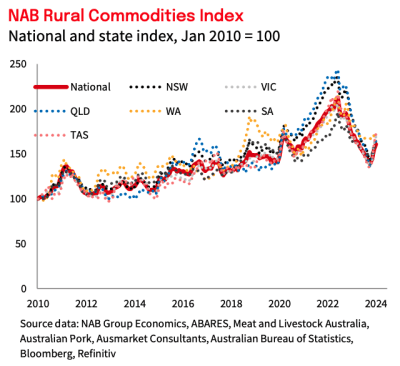Rising cattle prices, now around 60 percent higher than their October lows, have underpinned a strong rise in NAB’s Rural Commodities Index.
 NAB reported today that its index increased 2.2 percent month-on-month in January, and is now back up around levels last seen in May 2023
NAB reported today that its index increased 2.2 percent month-on-month in January, and is now back up around levels last seen in May 2023
In addition to Australian cattle, prices for lamb and dairy have also recorded gains, while prices for winter crops fell, weighed on by high global supply and weak demand.
NAB Group Economics, Associate Director, Lea Jurkovic, said cattle prices rose on the back of above-average rainfall at the end of 2023 and into 2024, which resulted in good pasture growth and buoyed producer confidence.
“Seasonal conditions were favourable in January, which was the ninth-wettest January on record,” Ms Jurkovic said.
“Exports were also strong in January and this demand combined with improved seasonal conditions should continue to support prices.
“Prices also increased similarly for lamb, with trade lamb prices rising nearly 25% month-on-month in January in monthly average terms, and were around 70pc higher than their September lows.
“Strong exports in January, as well as an improvement in consumer demand, supported prices. Lamb supply will likely come under pressure in the coming months, which will also buoy prices.
“Wool prices continue to track largely sideways, increasing a little in January in monthly average terms. Subdued demand from China, the main market for Australian wool, is weighing on prices.
“On average, dairy prices rose 7pc over the month in January and around 30% since November. Prices have risen for all dairy products. Production is expected to improve in 2024 after last year’s 30-year production low, which supported farmgate prices.”
Ms Jurkovic said in contrast, winter crop prices fell, weighed on by high global supply and weak demand.
“Wheat prices have continued to ease and in January at $370/tonne on average were around their May 2023 levels,” Ms Jurkovic said.
“Barley prices also continued to ease in January in monthly average terms, driven by a soft decline in the feed barley price with malting barley prices relatively stable. Meanwhile, canola prices fell a little over January.
“Fertiliser prices ticked up month-on-month in January, as prices of natural gas and urea moved upwards. Supply chain risks in the Red Sea could prove a near-term upside risk to fertiliser prices.”
As expected, the RBA left the cash rate unchanged in February at 4.35% and NAB forecasts rate cuts to begin in November 2024.
To read the full NAB February Rural Commodities Wrap, click here to download PDF
* The NAB Rural Commodities Index is based on the price and production data for 28 commodities and is weighted by their relative size in Australia’s agricultural sector.



